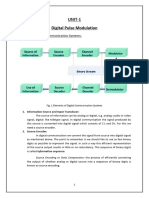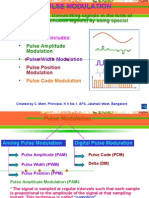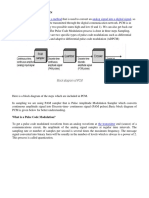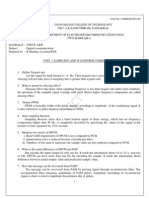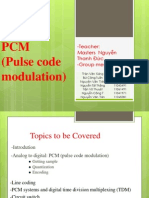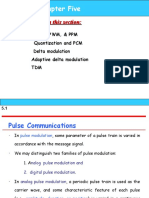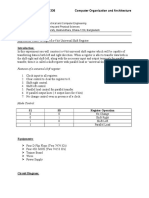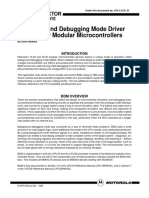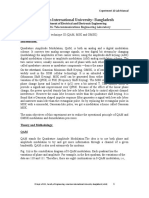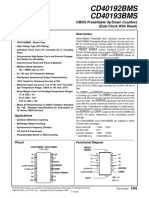Introduction to Pulse Modulation
What is the need for Pulse Modulation?
Many Signals in Modern Communication Systems are digital
Also, analog signals are transmitted digitally.
Reduced distortion and improvement in signal to noise ratios.
PAM, PWM, PPM, PCM and DM.
In CW modulation schemes some parameter of modulated wave varies continuously with
message.
In Analog pulse modulation some parameter of each pulse is modulated by a particular
sample value of the message.
Pulse modulation is of two types
o Analog Pulse Modulation
Pulse Amplitude Modulation (PAM)
Pulse width Modulation (PWM)
Pulse Position Modulation (PPM)
o Digital Pulse Modulation
Pulse code Modulation (PCM)
Delta Modulation (DM)
Pulse Code Modulation:
Three steps involved in conversion of analog signal to digital signal
Sampling
Quantization
Binary encoding
4
� Fig. 2 Conversion of Analog Signal to Digital Signal
Note: Before sampling the signal is filtered to limit bandwidth.
Elements of PCM System:
Fig. 3 Elements of PCM System
Sampling:
Process of converting analog signal into discrete signal.
Sampling is common in all pulse modulation techniques
5
� The signal is sampled at regular intervals such that each sample is proportional to
amplitude of signal at that instant
Analog signal is sampled every 𝑇𝑠 𝑆𝑒𝑐𝑠, called sampling interval. 𝑓𝑠=1/𝑇𝑆 is called
sampling rate or sampling frequency.
𝑓𝑠=2𝑓𝑚 is Min. sampling rate called Nyquist rate. Sampled spectrum (𝜔) is repeating
periodically without overlapping.
Original spectrum is centered at 𝜔=0 and having bandwidth of 𝜔𝑚. Spectrum can be
recovered by passing through low pass filter with cut-off 𝜔𝑚.
For 𝑓𝑠<2𝑓𝑚 sampled spectrum will overlap and cannot be recovered back. This is
called aliasing.
Sampling methods:
Ideal – An impulse at each sampling instant.
Natural – A pulse of Short width with varying amplitude.
Flat Top – Uses sample and hold, like natural but with single amplitude value.
Fig. 4 Types of Sampling
Sampling of band-pass Signals:
A band-pass signal of bandwidth 2fm can be completely recovered from its samples.
Min. sampling rate =2×𝐵𝑎𝑛𝑑𝑤𝑖𝑑𝑡ℎ
=2×2𝑓𝑚=4𝑓𝑚
Range of minimum sampling frequencies is in the range of 2×𝐵𝑊 𝑡𝑜 4×𝐵𝑊
Instantaneous Sampling or Impulse Sampling:
Sampling function is train of spectrum remains constant impulses throughout
frequency range. It is not practical.
6
�Natural sampling:
The spectrum is weighted by a sinc function.
Amplitude of high frequency components reduces.
Flat top sampling:
Here top of the samples remains constant.
In the spectrum high frequency components are attenuated due sinc pulse roll off.
This is known as Aperture effect.
If pulse width increases aperture effect is more i.e. more attenuation of high
frequency components.
Sampling Theorem:
7
�8
�9
�10
�11
� Fig. 7 (a) Sampled version of signal x(t)
(b) Reconstruction of x(t) from its samples
12
�PCM Generator:
13
�Transmission BW in PCM:
14
�PCM Receiver:
Quantization
The quantizing of an analog signal is done by discretizing the signal with a number of
quantization levels.
15
� Quantization is representing the sampled values of the amplitude by a finite set of
levels, which means converting a continuous-amplitude sample into a discrete-time
signal
Both sampling and quantization result in the loss of information.
The quality of a Quantizer output depends upon the number of quantization levels
used.
The discrete amplitudes of the quantized output are called as representation levels
or reconstruction levels.
The spacing between the two adjacent representation levels is called a quantum or
step-size.
There are two types of Quantization
o Uniform Quantization
o Non-uniform Quantization.
The type of quantization in which the quantization levels are uniformly spaced is
termed as a Uniform Quantization.
The type of quantization in which the quantization levels are unequal and mostly the
relation between them is logarithmic, is termed as a Non-uniform Quantization.
Uniform Quantization:
• There are two types of uniform quantization.
– Mid-Rise type
– Mid-Tread type.
• The following figures represent the two types of uniform quantization.
• The Mid-Rise type is so called because the origin lies in the middle of a raising part of
the stair-case like graph. The quantization levels in this type are even in number.
• The Mid-tread type is so called because the origin lies in the middle of a tread of the
stair-case like graph. The quantization levels in this type are odd in number.
• Both the mid-rise and mid-tread type of uniform quantizer is symmetric about the
origin.
16
�Quantization Noise and Signal to Noise ratio in PCM System:
17
�18
�19
�Derivation of Maximum Signal to Quantization Noise Ratio for Linear Quantization:
20
�Non-Uniform Quantization:
In non-uniform quantization, the step size is not fixed. It varies according to certain
law or as per input signal amplitude. The following fig shows the characteristics of Non
uniform quantizer.
21
�Companding PCM System:
• Non-uniform quantizers are difficult to make and expensive.
• An alternative is to first pass the speech signal through nonlinearity before
quantizing with a uniform quantizer.
• The nonlinearity causes the signal amplitude to be compressed.
– The input to the quantizer will have a more uniform distribution.
• At the receiver, the signal is expanded by an inverse to the nonlinearity.
• The process of compressing and expanding is called Companding.
22
�23
�Differential Pulse Code Modulation (DPCM):
Redundant Information in PCM:
24
�25
�26
�Line Coding:
In telecommunication, a line code is a code chosen for use within a communications
system for transmitting a digital signal down a transmission line. Line coding is often used
for digital data transport.
The waveform pattern of voltage or current used to represent the 1s and 0s of a
digital signal on a transmission link is called line encoding. The common types of
27
�line encoding are unipolar, polar, bipolar and Manchester encoding. Line codes are used
commonly in computer communication networks over short distances.
28
�Time Division Multiplexing:
29
� TDM is immune to nonlinearities in the channel as a source of crosstalk. The reason
for this behaviour is that different message signals are not simultaneously applied to the
channel.
Introduction to Delta Modulation
30
�31
�32
�33
�34
�35
�Condition for Slope overload distortion occurrence:
Slope overload distortion will occur if
36
�Expression for Signal to Quantization Noise power ratio for Delta
Modulation:
37
�38
�39



